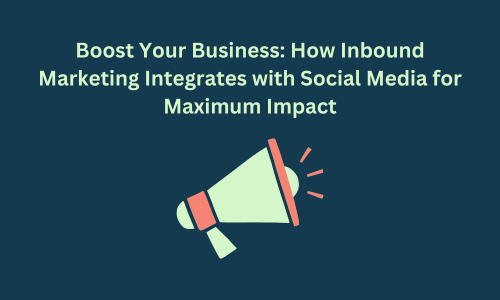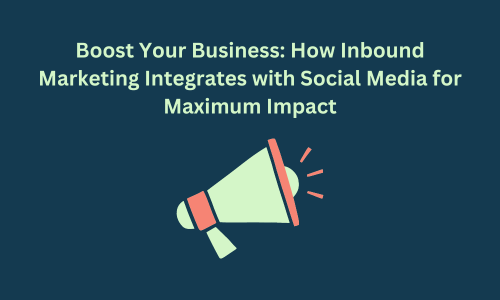


In today’s digital landscape, businesses need to do more than just push out advertisements and hope for conversions. Instead, the modern approach relies on building meaningful relationships with customers through valuable content and engaging experiences. This is where inbound marketing thrives. And when you blend inbound marketing with the power of social media, you get an unbeatable combination for attracting, engaging, and delighting your target audience. In this article, we’ll explore how inbound marketing seamlessly integrates with social media to create maximum impact for your business.
Inbound marketing is a strategy focused on attracting customers by providing relevant and helpful content, rather than bombarding them with disruptive ads. Instead of shouting your message to the masses, inbound marketing pulls customers in through blogs, videos, webinars, and other content that answers their questions or solves their problems.
The goal is simple: to create value at every stage of the customer journey, turning strangers into visitors, visitors into leads, leads into customers, and customers into promoters of your brand.
Social media platforms have become an essential component of any digital marketing strategy. From Facebook and Instagram to LinkedIn and Twitter, these platforms allow businesses to engage with their audience in real time, amplifying the reach of inbound content.
But social media’s value to inbound marketing goes beyond just distribution. It fosters two-way communication, providing opportunities for brands to build trust and relationships. It’s a space where customers can interact with your content, ask questions, and share their experiences—all of which enrich the inbound marketing journey.
Here’s how you can integrate inbound marketing elements with social media to boost results:
1. Content Creation and Distribution
At the core of inbound marketing is high-quality content. Social media serves as the megaphone that broadcasts this content to a larger audience.
Blog promotion: Share snippets of blog posts with engaging headlines and visuals on platforms like Markethive, Facebook, LinkedIn, and Twitter to drive traffic back to your website.
Video content: Create short, engaging videos for Instagram Reels, TikTok, or YouTube to convey your message more effectively. Repurpose longer blog posts into quick explainer videos or tutorials.
Visual storytelling: Use platforms like Pinterest or Instagram to turn content into infographics or visual guides, catering to visual learners and mobile audiences.
By leveraging social media, your content gains increased visibility, encouraging shares, comments, and clicks that drive visitors to your website.
2. Engagement and Building Relationships
One of the strongest advantages social media offers is its ability to engage users directly and create communities. Social platforms encourage real-time interaction, turning passive content consumers into active participants.
Polls and Q&A sessions: Engage with followers by asking for their opinions on topics relevant to your industry, or hosting live Q&A sessions to answer common questions.
Community building: Create and manage Markethive, Facebook or LinkedIn groups where your customers can discuss industry trends, ask for advice, or share feedback. This builds trust and positions your brand as a thought leader.
Remember, inbound marketing is about building long-term relationships, and social media provides the perfect environment for fostering these connections.
3. Lead Generation Through Social Media
While inbound marketing nurtures potential leads, social media accelerates this process by offering multiple channels to capture and qualify them.
Lead magnets: Offer free resources like e-books, webinars, or checklists in exchange for users’ email addresses via social media posts or ads.
Targeted paid ads: Use Markethive, Facebook and Instagram’s powerful targeting tools to reach your ideal customers based on their behaviours, interests, and demographics. Pairing inbound-focused content with highly targeted social ads increases your chances of converting leads.
Calls to action (CTAs): Use strong CTAs in your social media bios, posts, and stories that link directly to landing pages offering free trials, consultations, or downloads.
In combination with inbound marketing’s personalized approach, social media can help you turn casual followers into highly qualified leads.
The inbound marketing funnel has three primary stages: awareness, consideration, and decision. Here’s how social media can support your strategy at each stage:
Awareness Stage
At the top of the funnel, the goal is to attract strangers and turn them into visitors. Social media allows you to reach a broad audience by sharing educational and entertaining content.
Share how-to guides, tips, or industry news that help potential customers solve problems they didn’t even know they had.
Use trending hashtags and join relevant conversations to increase your visibility.
Consideration Stage
In the middle of the funnel, your audience is evaluating their options. Here, social media helps you nurture these visitors into leads by offering more in-depth content that guides their decision-making process.
Share case studies, product reviews, or comparison posts.
Use Instagram Stories or Markethive and LinkedIn posts to offer exclusive insights into how your product or service works, providing value beyond the sales pitch.
Decision Stage
At the bottom of the funnel, your potential customers are ready to make a purchase. This is where social media can push them to act by promoting testimonials, user-generated content, and time-sensitive offers.
Use retargeting ads on Facebook or Instagram to remind users of a product they’ve browsed on your website, helping them make the final decision.
Share customer success stories and user-generated content to showcase real-world results.
Social media offers robust analytics that allows you to track how your inbound marketing efforts are performing. To measure the effectiveness of your strategy, monitor key performance indicators (KPIs) such as:
To maximize the impact of social media on your inbound marketing strategy, follow these best practices:
Integrating social media into your inbound marketing strategy allows you to reach a wider audience, build meaningful relationships, and generate high-quality leads. By using social media as both a content distribution channel and a community-building tool, you can enhance every stage of the inbound funnel—attracting visitors, nurturing leads, and converting them into customers.
As social media continues to evolve, its role in inbound marketing will only grow more significant. The key is to be strategic, consistent, and always focused on providing value to your audience. Now’s the time to start optimizing your inbound marketing with social media for maximum impact.
Disclaimer: This article is provided for informational purposes only. It is not offered or intended to be used as legal, tax, investment, financial, or other advice.
